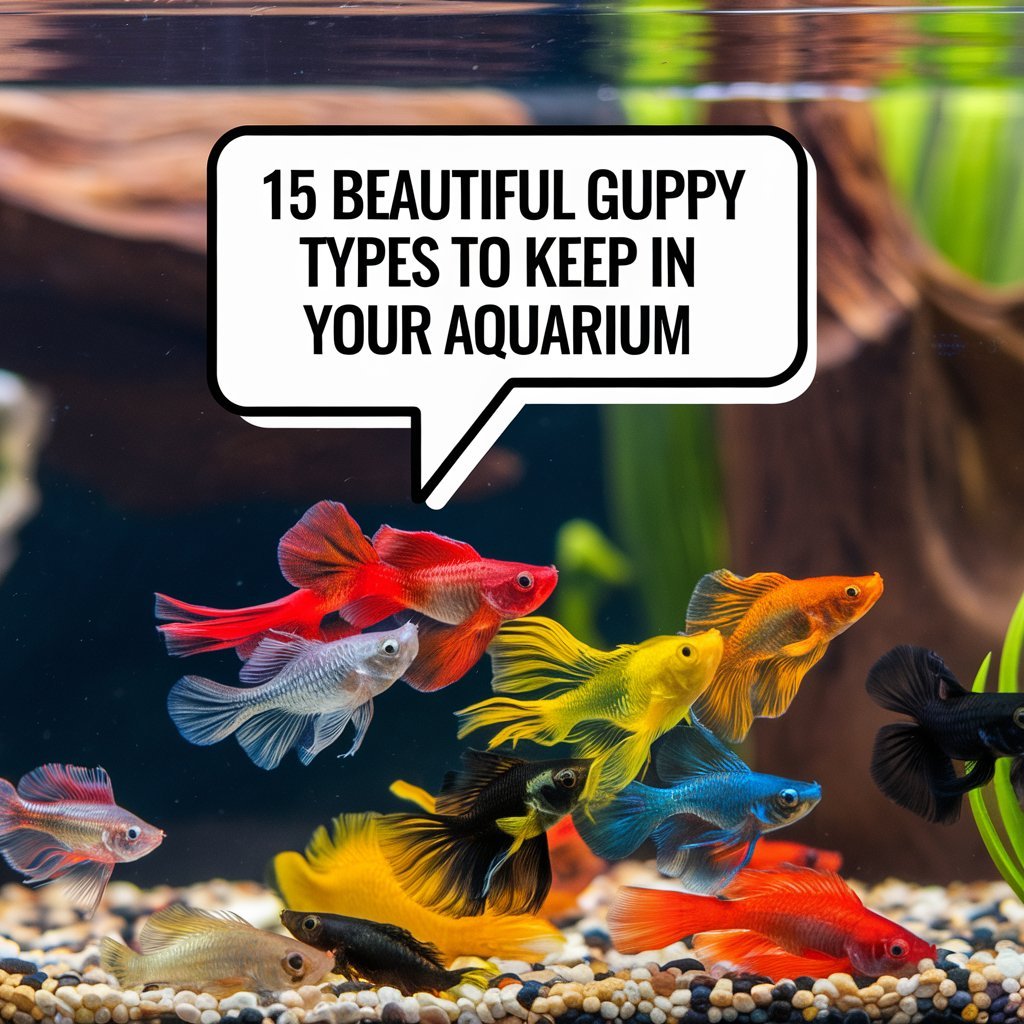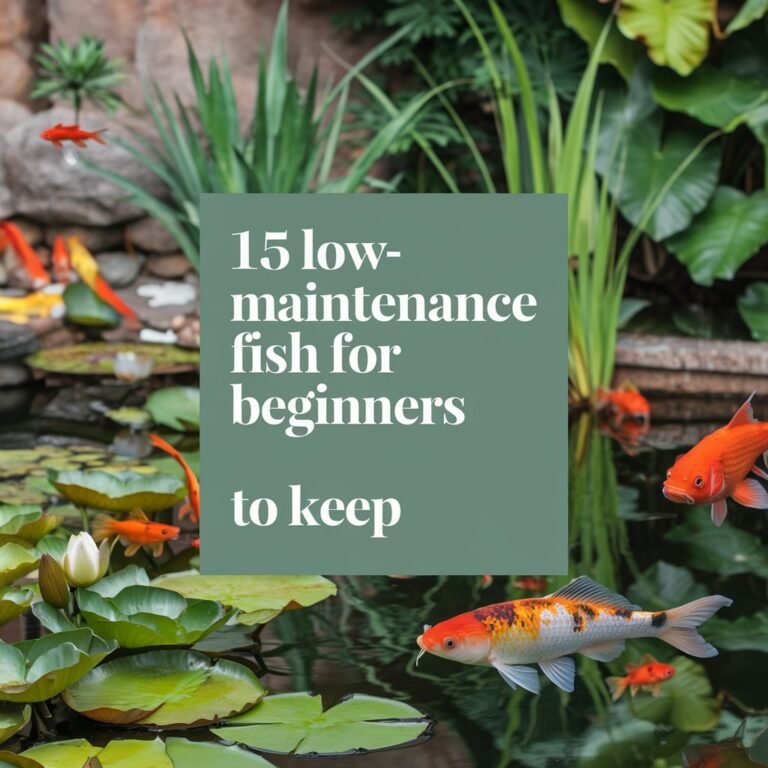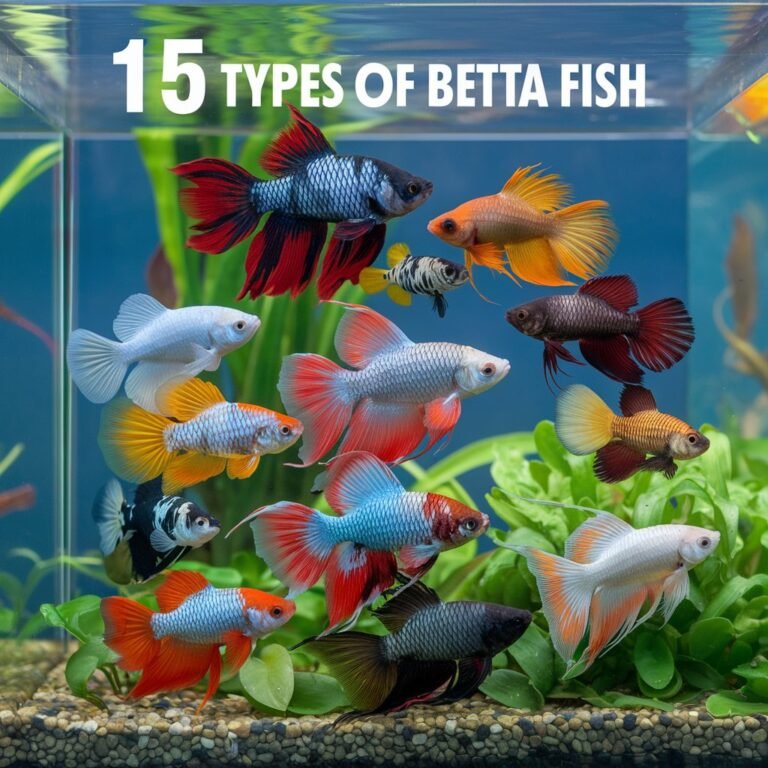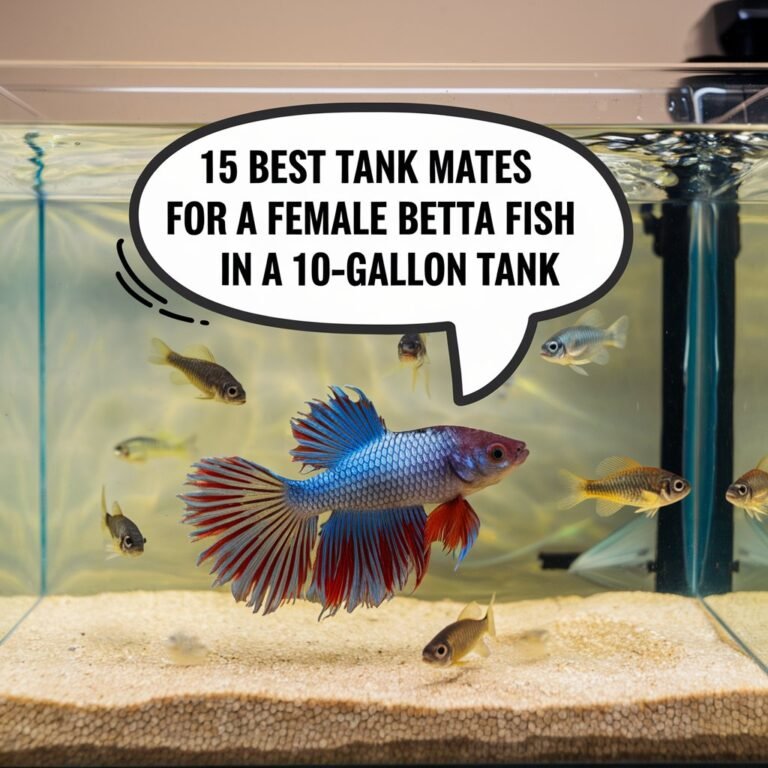15 Beautiful Guppy Types to Keep in Your Aquarium
If you’re looking to elevate your aquarium’s aesthetic, you’re in luck – 2024 brings an array of stunning guppy varieties to choose from. You’ll be spoiled for choice with options like the vibrant Neon Blue Tail Guppies and the mesmerizing Galaxy Tailed Guppies.
But what sets these types apart from one another, and which ones will thrive in your specific aquarium setup? To find the perfect fit, you’ll want to weigh factors like care requirements, color preferences, and the overall style you’re aiming to achieve.
In A Nutshell
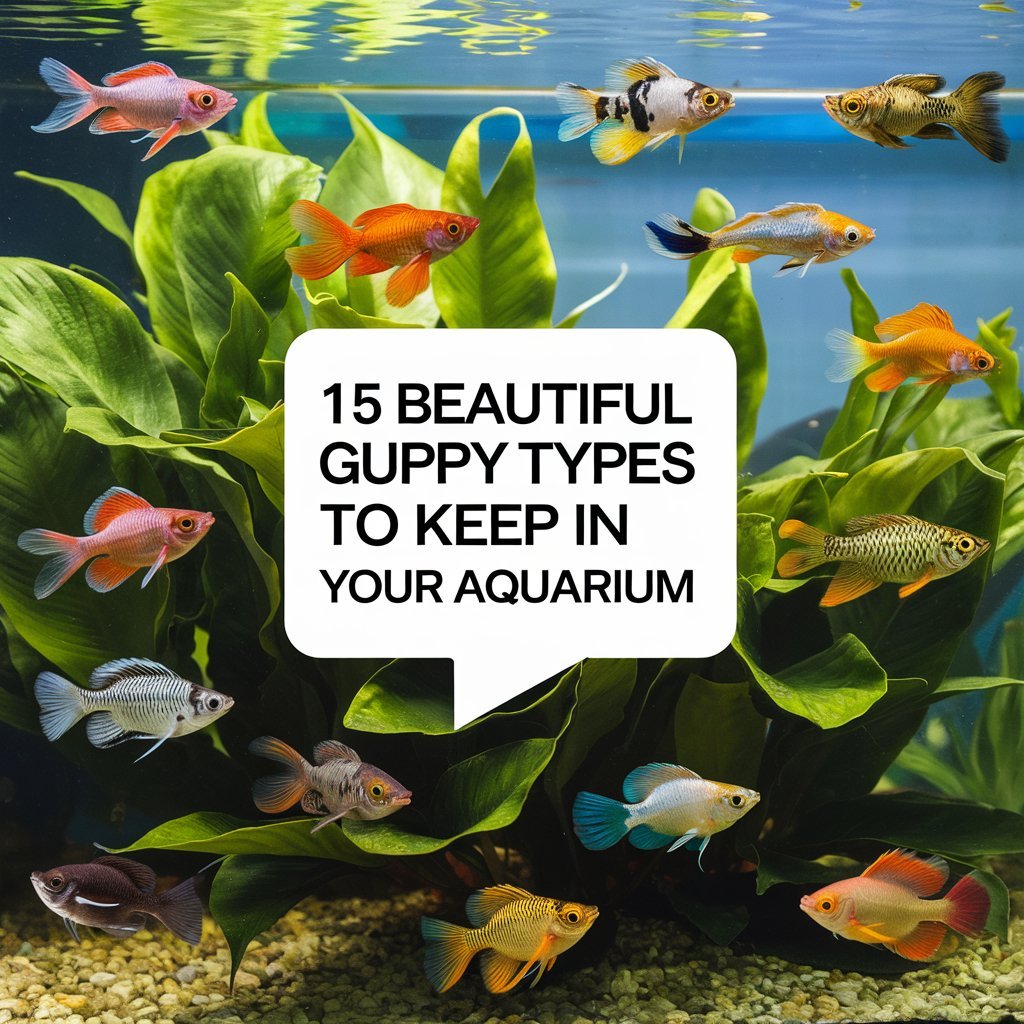
- Neon Blue Tail Guppies display vibrant blue and neon colors on their tail and dorsal fin.
- Golden Snakeskin Guppies feature a golden color with a Snakeskin pattern due to genetic variation.
- Turquoise Iridium Guppies showcase a turquoise hue with an iridescent sheen from microscopic plate-like structures.
- Crystal White Tuxedo Guppies have a white body with a black tail, resulting from recessive white coloration and Tuxedo genetics.
- Merah Fire Guppies exhibit vibrant, fiery hues with fire patterns on their tails, fins, and bodies.
Neon Blue Tail Guppies
When you’re looking for a striking addition to your aquarium, consider the Neon Blue Tail Guppy. This popular guppy type boasts vibrant blue and neon colors that catch the eye.
To maintain the desired coloration, you’ll want to breed Neon Blue Tail Guppies selectively. Their breeding habits are similar to those of other guppy types: they’re livebearers that produce between 2-200 fry per spawn, with an average of 30-50.
In terms of color variations, Neon Blue Tail Guppies can exhibit different shades of blue, from light sky blue to deep navy.
The blue coloration typically appears on the tail and can extend to the dorsal fin. Some specimens may also display red or green highlights on their fins and bodies.
You can enhance the color intensity of your Neon Blue Tail Guppies by providing a balanced diet and maintaining ideal water conditions.
Golden Snakeskin Guppies
Several Golden Snakeskin Guppies can thrive in a well-maintained aquarium, provided you offer them suitable conditions and proper care.
To keep these guppies healthy, you’ll need a tank with a capacity of at least 10 gallons and stable water parameters. A temperature range of 72°F to 82°F (22°C to 28°C) and a pH between 6.8 and 7.8 are ideal for these fish.
If you’re interested in breeding Golden Snakeskin Guppies, it’s crucial to understand the Golden genetics behind their unique coloration.
The golden color is a result of a specific genetic variation that affects the production of melanin. This variation can be combined with other genes to create different shades and patterns.
The Snakeskin history dates back to the 1970s when breeders first developed this strain.
The distinctive snakeskin pattern is caused by the interaction of multiple genes that control the development of scales and coloration. By selecting for specific traits, breeders have created a wide range of Snakeskin varieties, including the Golden Snakeskin Guppy.
With proper care and attention, you can enjoy the beauty of these stunning fish in your aquarium.
Violet Metallic Guppies
In a well-designed aquarium, you can showcase the stunning beauty of Violet Metallic Guppies.
These guppies are known for their striking appearance, featuring a mainly violet body with iridescent scales that reflect a metallic sheen.
The Violet Metallic Guppy’s coloration is a result of the way microscopic crystals in their scales refract light, giving them an otherworldly appearance.
When selecting Violet Metallic Guppies for your aquarium, look for individuals with vibrant violet shades and a strong metallic sheen.
A well-bred Violet Metallic Guppy will have a deep, rich coloration that’s evenly distributed across its body.
The fins and tail should be long and flowing, with a delicate pattern of violet and metallic hues.
To bring out the best in your Violet Metallic Guppies, provide them with a well-planted aquarium featuring plenty of hiding places and open swimming areas.
Maintain good water quality and a temperature range of 72-82°F (22-28°C).
With proper care, your Violet Metallic Guppies will thrive and become a stunning addition to your aquarium.
Cobalt Blue Delta
A striking variant of the guppy species, the Cobalt Blue Delta boasts a mesmerizing blue coloration with triangular-shaped fins and tail, hence its name.
You’ll notice that the blue coloration is a result of the unique Blue genetics that this variant possesses. This genetic trait is responsible for the vibrant blue hue that sets the Cobalt Blue Delta apart from other guppy types.
When it comes to the Delta finnage, you’ll observe that the fins and tail are triangular in shape, which is a characteristic of the Delta fin type.
This finnage style is highly sought after by guppy enthusiasts due to its unique appearance and striking visual appeal.
If you’re considering adding the Cobalt Blue Delta to your aquarium, you’ll want to guarantee that you provide the right environment for this variant to thrive.
This includes maintaining ideal water conditions, providing a balanced diet, and creating a habitat that promotes healthy growth and development.
By doing so, you’ll be able to enjoy the beauty and uniqueness of the Cobalt Blue Delta in your aquarium.
With proper care, this variant can make a stunning addition to your guppy collection.
Galaxy Tailed Guppies
You’ve likely encountered guppies with striking finnage, but the Galaxy Tailed Guppies take this trait to the next level.
Their elaborate tails, often featuring Galaxy colors, set them apart from other Tailed varieties. Galaxy Tailed Guppies boast vibrant, iridescent hues that seem to shift and change as they move through the water.
These colors can range from deep blues and purples to bright pinks and greens, creating a mesmerizing effect.
When selecting Galaxy Tailed Guppies for your aquarium, look for individuals with well-defined tail shapes and vibrant coloration.
A healthy Galaxy Tailed Guppy will have a sturdy tail that’s free of damage or disease.
It’s also essential to research the specific care requirements for Galaxy Tailed Guppies, as they may have unique needs compared to other guppy varieties.
In terms of breeding, Galaxy Tailed Guppies can be a bit more challenging to work with due to their complex finnage.
However, with proper care and attention, you can successfully breed these stunning guppies and enjoy their Galaxy-inspired beauty in your aquarium.
Grasshopper Yellow Guppies
Throughout your exploration of various guppy types, chances are you’ll come across the Grasshopper Yellow Guppy, boasting an intense, sunny hue that commands attention.
This vibrant coloration is a result of the Yellow Genetics that dominate their genetic makeup. The Grasshopper Yellow Guppy’s body is mainly yellow, with some specimens displaying subtle green or blue undertones.
When it comes to creating a suitable Guppy Habitat for your Grasshopper Yellow Guppies, you’ll want to focus on replicating their natural environment.
Provide a well-planted aquarium with plenty of hiding places and visual barriers. A temperature range of 72-82°F (22-28°C) and pH levels between 6.8-8.5 will help keep your guppies healthy and thriving.
In terms of tankmates, Grasshopper Yellow Guppies are generally peaceful and can be kept with other community fish.
However, to ensure their well-being, avoid housing them with fin-nippers or aggressive species that may harass or stress your guppies. By providing a suitable environment and compatible tankmates, you can enjoy the vibrant beauty of your Grasshopper Yellow Guppies for years to come.
With proper care, these stunning guppies can live up to 3-5 years in captivity.
Turquoise Iridium Guppies
Beyond the vibrant colors of the Grasshopper Yellow Guppy, another stunning variety commands attention – the Turquoise Iridium Guppy, boasting a mesmerizing turquoise hue that’s achieved through advanced selective breeding.
This variety is highly prized among guppy enthusiasts for its unique, iridescent sheen. The Iridium shine is the result of microscopic plate-like structures in the fish’s scales that refract light, giving the Turquoise Iridium Guppy an otherworldly appearance.
The Turquoise rarity is due in part to the difficulty of breeding these fish. Selective breeding programs require careful planning and execution to produce the desired traits, and even then, the results aren’t guaranteed.
However, for those willing to invest the time and effort, the reward is well worth it. Turquoise Iridium Guppies aren’t only visually stunning, but they’re also relatively small, making them a great choice for smaller aquariums.
When keeping Turquoise Iridium Guppies, it is crucial to provide them with plenty of hiding places and plants to reduce stress. A balanced diet and regular water changes will also help to keep these fish healthy and thriving.
With proper care, Turquoise Iridium Guppies can be a beautiful and rewarding addition to your aquarium.
Spotted Palaemon Guppies
While the Turquoise Iridium Guppy‘s iridescent sheen is undeniably enthralling, the Spotted Palaemon Guppy offers a unique charm of its own, with its striking spotted pattern and vibrant colors.
You’ll find that this guppy type is well-suited for freshwater habitats, thriving in temperatures between 72°F and 82°F (22°C and 28°C). As an active swimmer, the Spotted Palaemon Guppy requires ample space to move around, making it an ideal choice for community aquariums with plenty of hiding places and plants.
When introducing Spotted Palaemon Guppies to your aquarium, it’s vital to weigh their compatibility with other aquatic companions.
They’re generally peaceful and can coexist with other guppy species, as well as small, non-aggressive fish like neon tetras or harlequin rasboras. However, it’s imperative to avoid housing them with fin-nippers or aggressive species that may harass or stress them out.
Crystal White Tuxedo
The Crystal White Tuxedo guppy’s striking appearance, characterized by its mainly white body and black tail, makes it a standout in any aquarium.
You’ll be drawn to its unique coloration, which is a result of careful breeding and a deep understanding of Tuxedo genetics.
As you explore the world of guppy breeding, you’ll discover that the Crystal White Tuxedo is a product of selective breeding, where breeders have emphasized the white coloration while maintaining the distinctive black tail.
When it comes to breeding Crystal White Tuxedos, you’ll need to understand the underlying genetics that create this unique color pattern.
Guppy breeding secrets reveal that the white coloration is recessive, meaning that it requires a specific combination of genes to express.
By understanding these genetics, you can breed Crystal White Tuxedos with confidence, creating a stunning addition to your aquarium.
As you plunge deeper into Tuxedo genetics exploration, you’ll uncover the intricacies of creating this striking color pattern.
With patience, practice, and a solid understanding of guppy breeding principles, you can successfully breed Crystal White Tuxedos and enjoy their beauty in your aquarium.
Lavender Ribbon Tails
The Lavender Ribbon Tail is a rare and exquisite variant of the popular Ribbon Tail betta fish. Characterized by its delicate, flowing fins and striking lavender hue, this beautiful fish is a prized addition to any aquarium.
The soft, pastel coloration of the Lavender Ribbon Tail is a result of careful breeding and selection, and its elegant appearance is sure to captivate any fish enthusiast.
With proper care and attention, the Lavender Ribbon Tail can thrive in a well-maintained aquarium, its long, flowing fins waving gently in the current as it swims. Whether you’re a seasoned aquarist or just starting out, the Lavender Ribbon Tail is a stunning and rewarding fish to keep.
Purebred Royal Guppies
Diving into the world of Purebred Royal Guppies, you’ll discover a breed renowned for its striking appearance and majestic demeanor.
As their name suggests, they boast a royal lineage that dates back to the early days of guppy breeding. This heritage has been carefully preserved through strict breeding standards that prioritize the development of specific traits, such as vibrant colors, elaborate fins, and a robust build.
When it comes to breeding Purebred Royal Guppies, you’ll need to adhere to these standards to guarantee the quality and authenticity of your stock.
This involves selecting breeding pairs that exhibit the desired characteristics, such as a well-defined tail shape, a vibrant color palette, and a sturdy body. By doing so, you’ll be able to produce offspring that embody the true essence of the Royal Guppy lineage.
To maintain the integrity of your Purebred Royal Guppies, it’s crucial to keep accurate records of their lineage and breeding history.
This will enable you to make informed decisions when selecting breeding pairs and help you avoid inbreeding, which can compromise the health and quality of your fish.
Plutonian Tail Guppies
With an eye for the unique, many guppy enthusiasts now seek out the distinctive features of Plutonian Tail Guppies, a breed known for its remarkable, crescent-shaped tail.
As you explore this fascinating world, you’ll find that the Plutonian Tail’s defining characteristic lies in its distinctive, half-moon shaped caudal fin, a striking contrast to more common tail shapes.
In addition to this exceptional tail feature, you can also observe notable tail variations in the breed, from nearly straight, sabre-like fins to half-fans or dramatic double tails.
Breeders meticulously work with this broad range of phenotypes, pursuing desired shapes while continually charting complex genetics.
It’s a painstaking task due to genetic randomness inherent to fin expression and proportions.
Amber Spotted Tails
As you explore the diverse world of guppy breeds, you’ll come across the striking Amber Spotted Tails, characterized by their vibrant, golden-brown spots that adorn their caudal fins.
The history of this breed is somewhat murky, but Spotted Tails, in general, originated in the early days of guppy breeding when hobbyists were experimenting with finnage patterns and colorations.
If you decide to add the Amber Spotted Tails to your collection, keep in mind some key care tips to guarantee they thrive in their new environment.
You should provide these fish with well-filtered, clean water, rich in dissolved oxygen and low in pollutants.
Additionally, these fish can be a bit shy and need places to hide.
As with all guppy breeds, water quality plays a crucial role, and keeping stable conditions (soft water pH around 6.5 and moderate temperature, ranging between 20 to 22 degrees Celsius) helps.
Breeding these beautiful guppies isn’t much more complex than maintaining the appropriate living environment and adhering to an aggressive program to filter food-rich compounds to confirm longevity in good quality waters for well-prolonged happiness for years in delightment at aquaria spectaculas by some today so never alone since everybody truly together united brings much nice true happiness of a happy life.
Merah Fire Guppies
Merah Fire Guppies boast vibrant, fiery hues that set them apart from other guppy breeds.
You’ll notice their striking fire patterns, which can range from deep oranges to bright yellows, often with intricate details and markings. These patterns can be found on their tails, fins, and even bodies, making them a stunning addition to your aquarium.
When it comes to breeding Merah Fire Guppies, you may face some challenges.
They require specific water conditions, such as a pH range of 7.0-8.0 and temperatures between 72-82°F (22-28°C). Additionally, they can be sensitive to changes in water quality, so regular water changes and monitoring are vital.
Breeding Merah Fire Guppies also requires a good understanding of genetics, as their fire patterns can be influenced by multiple genes.
If you’re up for the challenge, breeding Merah Fire Guppies can be a rewarding experience.
With careful planning and attention to detail, you can create new and exciting variations of this beautiful breed. By understanding their specific needs and breeding requirements, you can successfully raise these stunning guppies and enjoy their vibrant colors in your aquarium.
Eclipse Micro Tails
Embracing the unique charm of the Eclipse Micro Tail guppy, you’ll notice its striking, half-tail design that sets it apart from other breeds.
This distinct Micro finnage contributes to its visual appeal and allows the guppy to conserve energy. By minimizing its tail, the Eclipse Micro Tail can focus its energy on swimming and exploring its surroundings.
Eclipse Micro Tail guppies showcase vibrant Eclipse colors that enhance their attractiveness.
The unique half-tail pattern highlights their exceptional beauty and rarity, making them highly sought after by guppy enthusiasts. With careful breeding and attention to genetics, these fish have been cultivated to showcase striking color patterns, which set them apart from other breeds.
If you’re interested in keeping an Eclipse Micro Tail in your aquarium, be sure to research specific care requirements to guarantee you’re providing the ideal environment for these fish to thrive.
This breed’s sensitivity and rarity necessitate extra care to prevent disease and promote longevity. With dedication and the right knowledge, you’ll be able to create an environment that highlights the exceptional beauty of your Eclipse Micro Tail guppies.
Frequently Asked Questions
What Water Temperature Suits Guppy Aquariums?
You’re setting up a guppy aquarium and wondering about the ideal water temperature. To maintain peak water quality, you’ll want to aim for a temperature range of 72-82°F (22-28°C), minimizing water quality fluctuations and temperature gradient variations.
How Often Should Guppies Be Fed?
You’ll want to establish a feeding schedule for your guppies, offering 2-3 meals daily. Be cautious not to overfeed, as this can lead to digestive issues and poor water quality, affecting their overall health.
Can Guppies Coexist With Other Fish?
When introducing guppies to your aquarium, you’ll want to choose peaceful breeds as fish companions to avoid conflicts. Research compatible species, like neon tetras or harlequin rasboras, to create a harmonious community.
What Tank Size Is Ideal for Guppies?
When choosing a tank size for guppies, you’re creating a thriving environment. A minimum 5-gallon tank suits their breeding habits and allows for adequate space for aquatic plants, ensuring a balanced ecosystem for your fish.
Are Guppies Prone to Any Specific Diseases?
You need to be aware that guppies are susceptible to diseases, especially fungal infections like Ich and Fin Rot, and bacterial outbreaks caused by poor water quality and stress.
FInal Verdict
You’ve now explored 15 stunning guppy types to adorn your aquarium in 2024. These varieties offer unique patterns and colors, from the radiant Neon Blue Tail Guppies to the mesmerizing Galaxy Tailed Guppies.
To guarantee they thrive, maintain proper water parameters and provide a suitable environment. With correct care, these guppies will captivate and bring beauty to your aquarium. Research and understand the specific needs of your chosen guppy type for peak results.
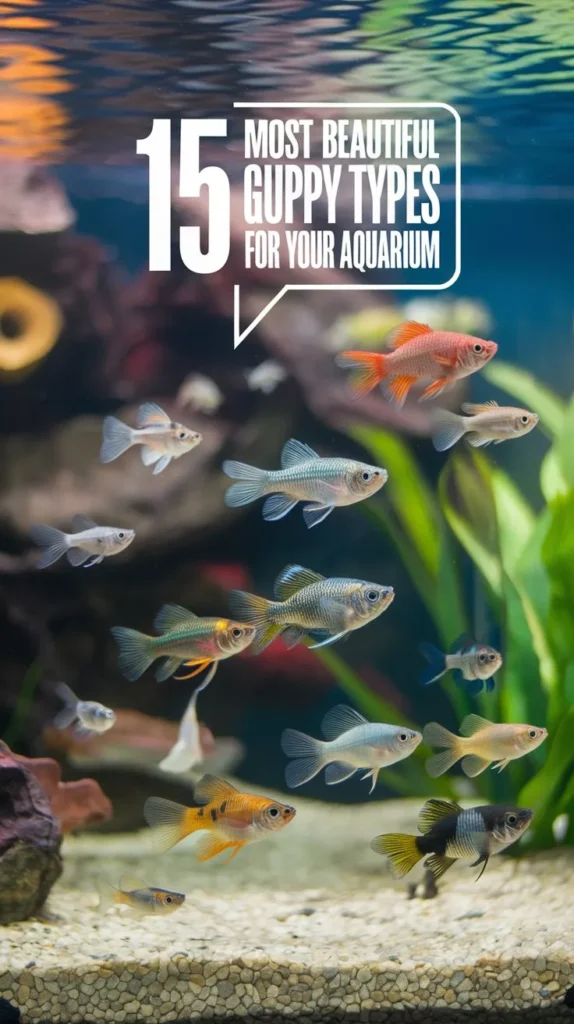
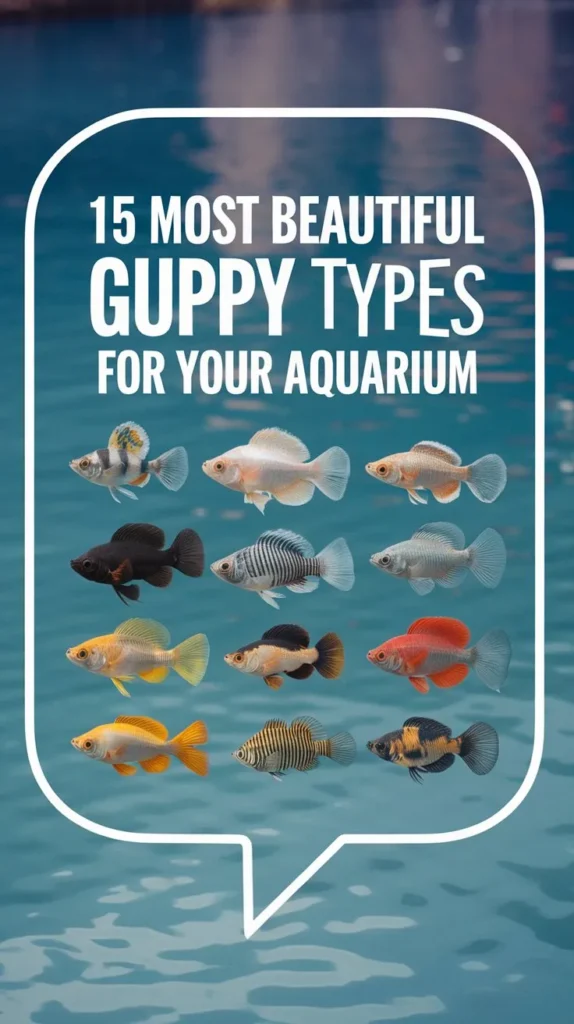
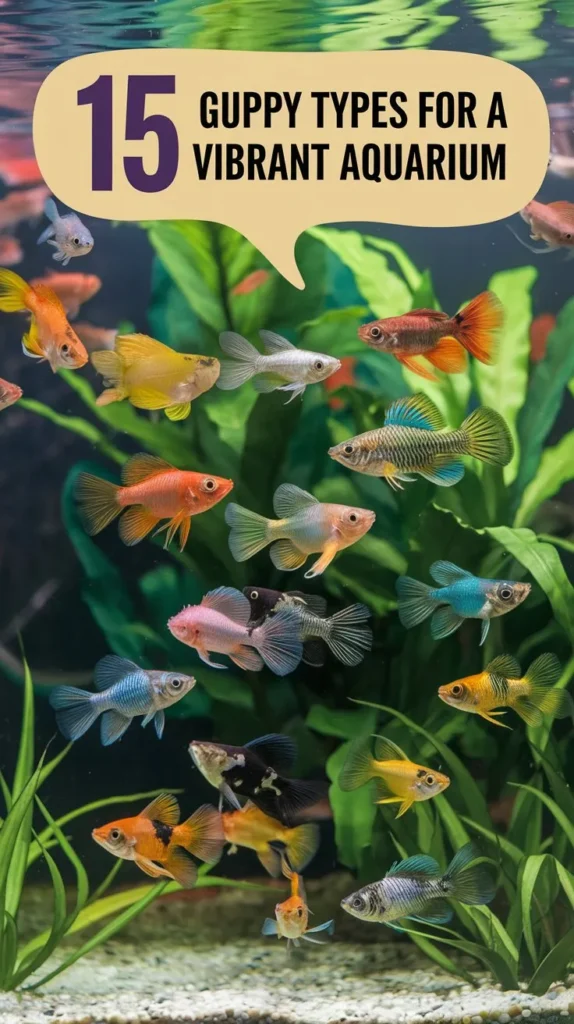
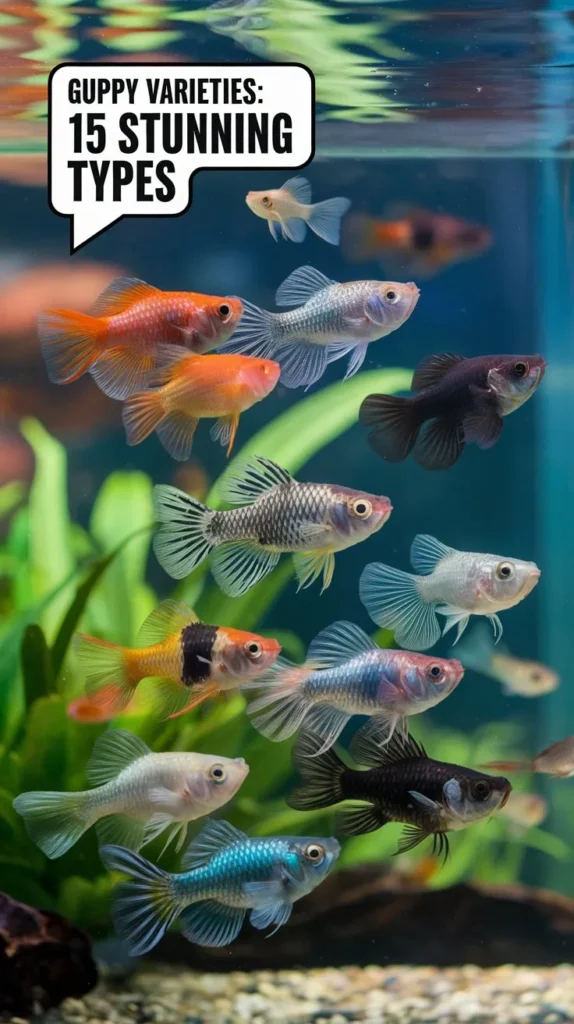
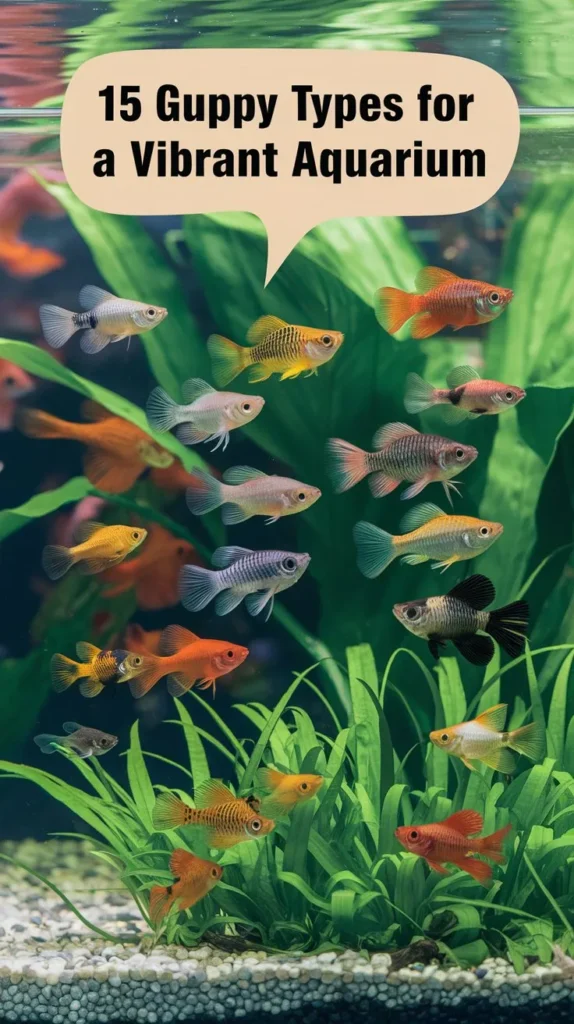
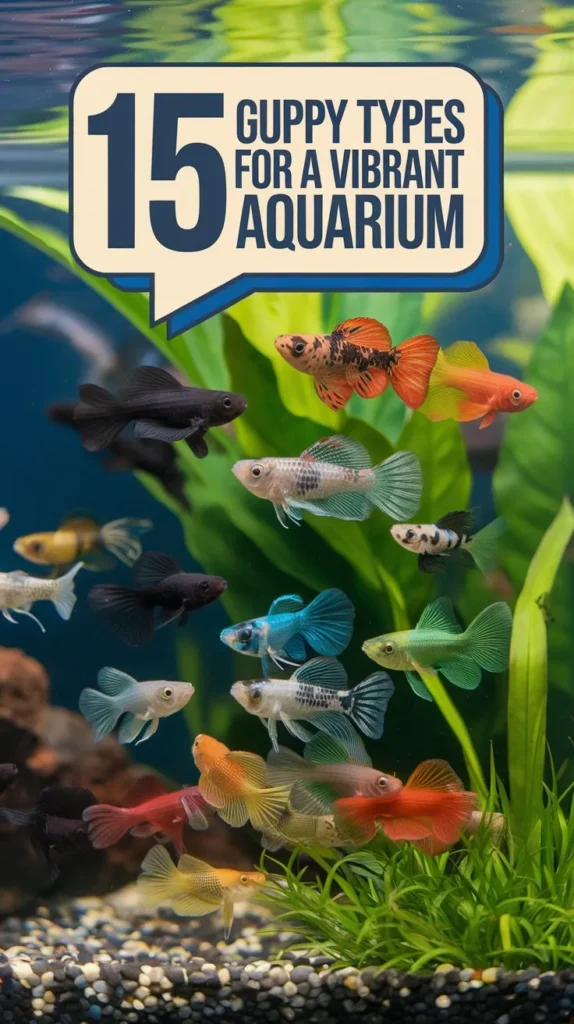
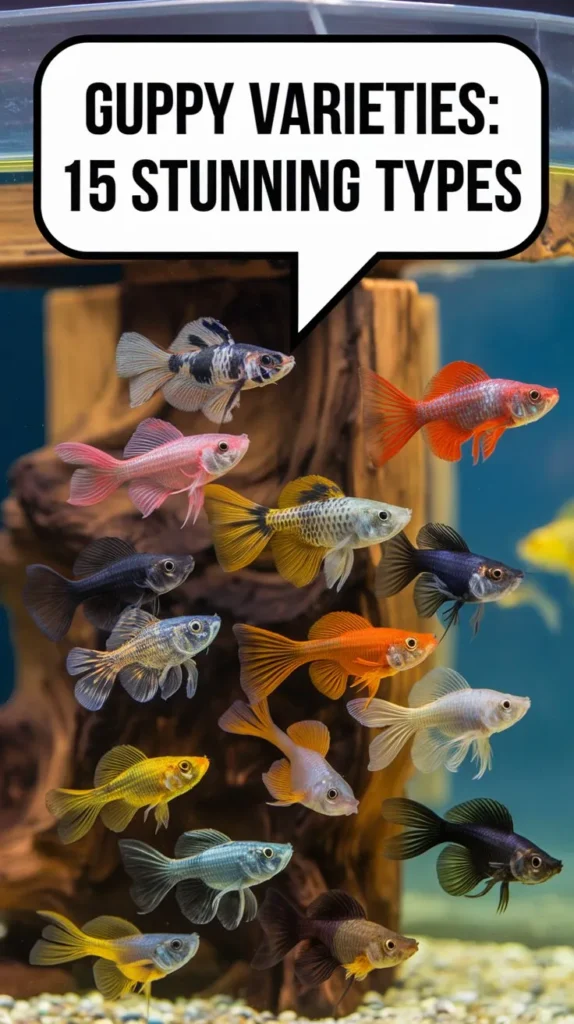
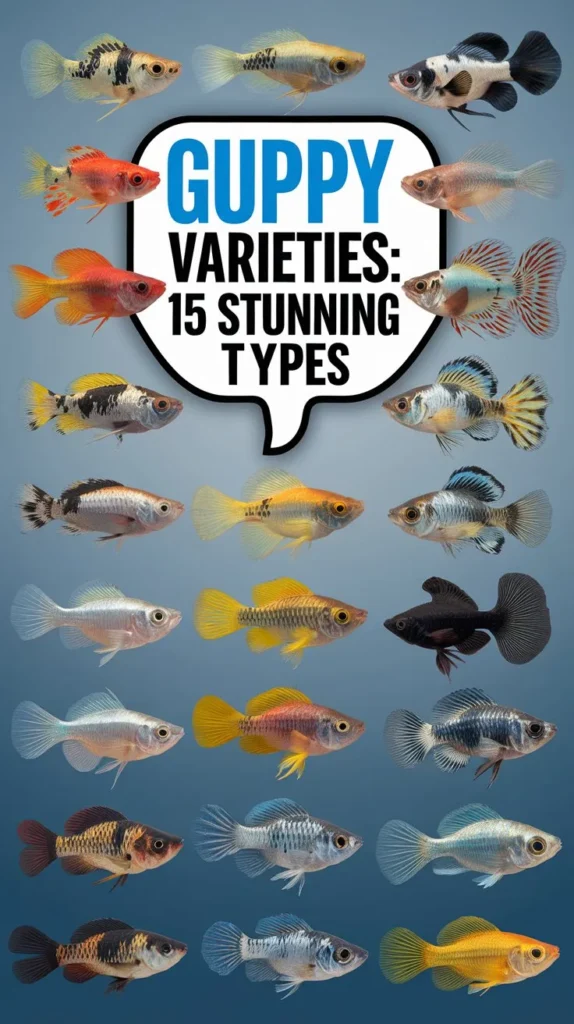
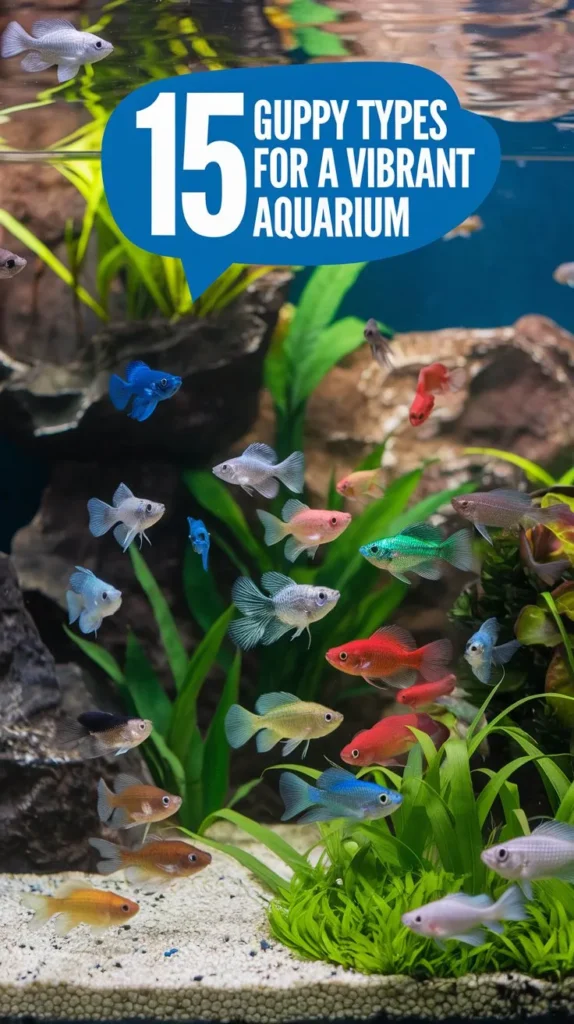

Hello, I’m Aria Cooper, the heart and soul behind Swimmy Buddies. As a devoted fish aficionado, I share my aquatic adventures and expertise to inspire your own underwater explorations. 🐠🌊

